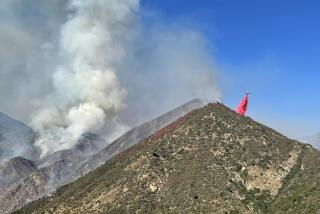Smoke, but no flames in Los Padres
- Share via
A patch of land in Ventura County’s section of Los Padres National Forest where the ground recently heated up to 812 degrees continues to puzzle firefighters and geologists after weeks of monitoring.
“It’s a thermal anomaly,” said Ron Oatman, spokesman for the Ventura County Fire Department.
Firefighters responded to reports of a blaze there a month and a half ago, when observers noticed smoke rising from the parched scrub. But when they arrived, they found no flames.
Firefighters and geologists who have surveyed the area in the Sespe Oil Field are uncertain what’s causing the heat, but they do have a theory.
Allen King, a retired geologist with the U.S. Forest Service who went to the site Friday, said the smoking ground is “a normal occurrence” that does not appear to be the result of human activity.
The hot spot is in an area considered to be an active landslide that has shifted for more than 60 years. Several hundred feet below its cracked surface lie pockets of gas, tar and oil.
King said he suspects cracks along the landslide’s slope allow oxygen to enter into the earth and hydrocarbon material to “seep out” of the fine-grain shale. The combination can create underground combustion, he said.
King said the depth at which hydrocarbon material can be found “varies tremendously” and that he does not know at what depth the combustion in the oil field is occurring. The 812-degree temperature was measured Friday about a foot below the surface, he said. No other temperature checks have been made since, according to Oatman.
During Friday’s visit to the hot spot, smoke rose through five cracks in the ground. From a distance, it looked like “a small, smoldering camp fire,” Oatman said. The smoke comes and goes, he said, and fire officials expect it will last until the next heavy rainfall, when water and mud plug the fissures.
The steep, rugged terrain is owned by the U.S. Bureau of Land Management and leased by Seneca Resources Corp. The area is gated off from public access and is free of equipment and buildings.
The hot spot is not considered to be a threat to public safety, Oatman said, and the Fire Department is monitoring the area daily.
The 3,000-acre Sespe Oil Field was discovered in 1887 and has since produced about 50 million barrels of oil, said David Christy, spokesman for the Bureau of Land Management. The field contains more than 300 oil wells, 210 of which are active. In January 2007, about 200 to 300 gallons of oil spilled into a nearby creek after a pipe containing a mixture of groundwater and oil burst.
Jeff Kuyper, executive director of Los Padres ForestWatch, said he had not heard of hot spots in the oil field but was concerned about their potential effect on the nearby Sespe Condor Sanctuary and the forest’s fire-prone nature.
“It’s just a disaster waiting to happen . . . regardless of what the cause is,” he said.
--
More to Read
Sign up for Essential California
The most important California stories and recommendations in your inbox every morning.
You may occasionally receive promotional content from the Los Angeles Times.









